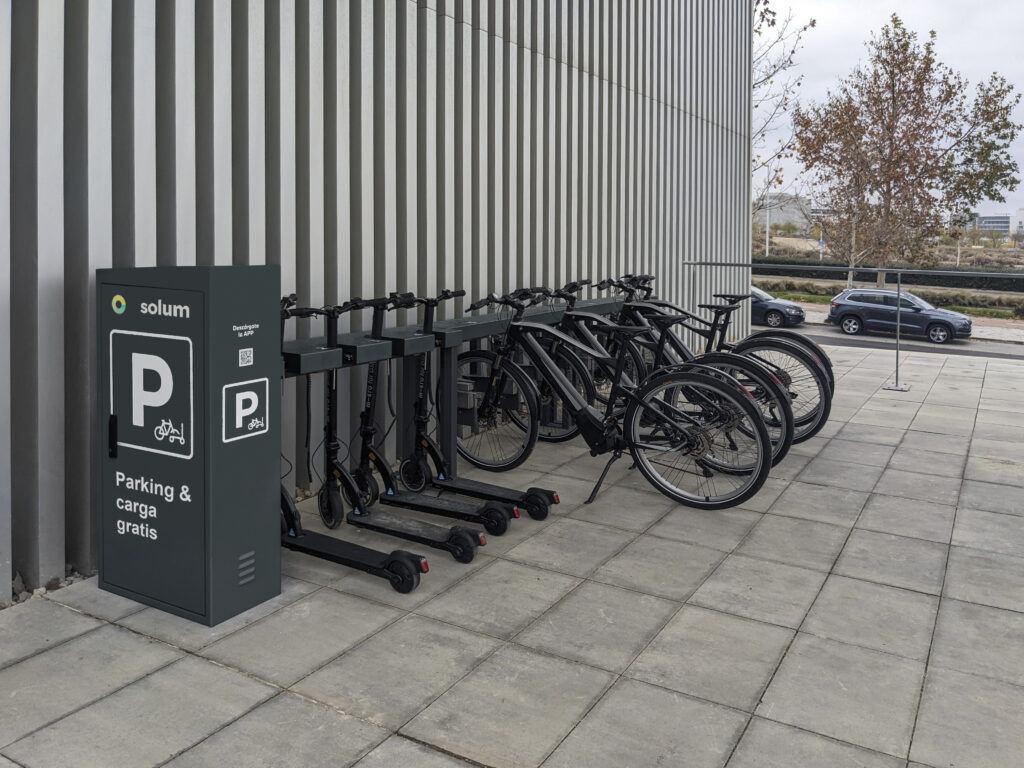Electric bicycles, also known as e-bikes, are rising in popularity as an alternative transportation method. They use an electric motor to assist with pedaling, enabling riders to cover longer distances and tackle challenging terrains with less effort than on a conventional bicycle. This sustainable vehicle has gained traction in recent years due to its mobility and environmental benefits.
In today’s post, we’ll discuss this trendy sustainable vehicle, exploring how electric bicycles work, their advantages, and where to charge them.
How does an electric bicycle work?
The operation of an electric bicycle relies on three key components: the motor, the battery, and the controls. Most e-bikes are equipped with a small electric motor, usually ranging from 250 to 750 watts, located either in the center or on the rear wheel of the frame. This motor is powered by a rechargeable lithium-ion battery with a capacity between 250 Wh and 500 Wh or more, mounted on the frame or under the seat.
The rider can control the assistance level through a switch or panel on the handlebar, allowing them to select between assistance levels ranging from low to full, depending on user needs and terrain. Generally, a high-capacity battery provides between 40 to 100 km of range per charge, depending on the assistance level and road conditions.
Pedal assistance modes and pedal sensors
E-bikes typically offer various pedal assistance modes, such as “eco” mode (low assistance) or “turbo” mode (maximum assistance). Pedal sensors detect the force with which the rider pedals and adjust the motor’s power accordingly, making the use efficient and adaptable to the rider’s needs.
Features of electric bicycles
Modern electric bicycles feature advanced technology to enhance user experience and energy efficiency:

- Energy recovery: Some e-bikes are equipped with an energy recovery system that recharges the battery during braking or on downhill rides.
- Digital display: E-bikes often include a display showing information like speed, battery level, assistance mode, and distance traveled, helping to plan each trip more effectively.
- Safety systems: Many e-bikes come with lights, reflectors, and anti-theft systems, making them safer for city and road use.
Advantages of using an e-bike
Electric bicycles offer numerous benefits, both for users and the environment:
- Pedaling comfort: Electric assistance makes it easier to climb hills and cover long distances without excessive effort.
- Accessibility for all: Seniors or individuals with physical limitations can travel more easily.
- Sustainability: E-bikes emit no pollutants and help reduce traffic in urban areas.
- Economic savings: They are more economical than a car, and many places offer tax incentives for purchasing one.
These features make electric bicycles a practical, eco-friendly choice that facilitates urban mobility and reduces environmental impact.

This leads us directly to the innovative projects developed by Solum. This Seville-based company focuses on optimizing available urban spaces to create renewable energy generation points, thus promoting sustainable infrastructure in cities. These stations not only provide practical benefits to e-bike users and other sustainable vehicle users, giving them convenient access to charging, but they also help reduce the carbon footprint, benefiting the environment.
Frequently asked questions
It’s essential to address common questions users may have about these eco-friendly vehicles.
¿Cuántas horas le dura la batería a una bicicleta eléctrica?
La duración de la batería de una bicicleta eléctrica varía según varios factores, incluida la capacidad de la batería y el nivel de asistencia al pedaleo seleccionado. En general, una batería promedio de una bicicleta eléctrica de 250-350 W/h, suele tardar entre 4 y 8 horas en cargarse por completo y puede proporcionar un rango de autonomía de aproximadamente 25 a 50 kilómetros (de 2 a 4h) con una sola carga, aunque esto puede variar según el modelo y las condiciones de uso.
¿Es necesario permiso, seguro o casco para conducir una bicicleta eléctrica?
Las regulaciones varían según la ubicación, por lo que es importante verificar las leyes locales. En muchos lugares, las bicicletas eléctricas que cumplen con ciertos límites de potencia y velocidad se clasifican como bicicletas convencionales y no requieren un permiso de conducir.
El uso de casco suele ser recomendado por razones de seguridad, pero la obligatoriedad depende de las leyes locales. En cuanto al seguro, generalmente no se requiere un seguro específico para bicicletas eléctricas, pero es aconsejable verificar si tu seguro de responsabilidad civil cubre cualquier incidente relacionado con el uso de la bicicleta eléctrica.
En España las bicicletas eléctricas con las características mencionadas no requieren seguro ni permiso de conducir. El uso de casco es obligatorio sólo en vías interurbanas para menores de 16 años. Puedes revisar la normativa en la Dirección General de Tráfico (DGT) para más detalles.
¿Dónde puedo cargar mi bicicleta eléctrica cuando estoy fuera de casa?
Desde Solum, hemos instalado estaciones de carga para vehículos eléctricos, incluyendo bicicletas eléctricas, en diferentes puntos de la ciudad o en centros comerciales. Esto te permite cargar tu bicicleta incluso cuando estás lejos de casa.
¿Qué diferencia a una bicicleta eléctrica de una moto eléctrica?
La diferencia clave es el sistema de propulsión. La bicicleta eléctrica requiere pedaleo para activar el motor, mientras que una moto eléctrica funciona con un acelerador y no necesita pedaleo. Además, las e-bikes suelen estar reguladas como bicicletas convencionales, mientras que las motos eléctricas necesitan permisos y cumplen otras regulaciones.
¿Puedo usar una bicicleta eléctrica bajo la lluvia o en condiciones climáticas adversas?
La mayoría de las bicicletas eléctricas están diseñadas para soportar condiciones climáticas normales, incluyendo la lluvia ligera. Sin embargo, es recomendable evitar sumergirlas en agua o exponerlas a condiciones climáticas extremadamente adversas. Siempre se debe seguir el mantenimiento adecuado para preservar la integridad de los componentes electrónicos.
The energy behind electric bicycles
The battery is the energy heart of electric bicycles. The most common ones are lithium-ion, providing between 700 and 1,000 charge cycles before losing effectiveness. This equals up to 50,000 kilometers of useful life, depending on usage and maintenance. Innovations in the sector include fast-charging stations, such as those created by Solum, which allow quick recharging at strategic locations, promoting electric bicycles as a viable and sustainable option for urban mobility.
Previously, we mentioned Solum, as this company has developed a solution for those who frequently use these electric vehicles. Although we see how practical they are in our daily lives, electric bicycles need to be recharged. This is why Solum has created charging stations for electric vehicles. These stations can be found at various locations around the city or even in shopping centers, ensuring that you can charge your bike even when you’re away from home.
Now that you know more about electric bikes and how they work, we invite you to visit our website to explore our projects and discover how we are driving sustainable mobility. We would love to read your comments and hear your thoughts!








